
Waverley Steps is a staircase which links Princes Street, Edinburgh and Waverley station.

Waverley Steps is a staircase which links Princes Street, Edinburgh and Waverley station.
The staircase was opened in 1902 as part of the development of the adjacent North British Hotel (the present-day Balmoral Hotel), which at the time belonged to the North British Railway Company together with Waverley station. [1] [ better source needed ]
The steps are flanked by original 1902 shops on the east and Waverley Market on the west. Waverley Market was originally a Victorian multi-level structure built on the site of a stone quarry. The original market was demolished in 1974 having become structurally unstable, and redeveloped ten years later as a multi-level underground shopping mall. It has been remodelled several times since then in an effort to increase its popularity, but with limited success. [2]
In 2010 Network Rail, the present owners of the station, replaced the original staircase with new stairs, an escalator and a lift (to the south) and added a weather-proof glass-and-steel canopy. The new steps were opened in 2012. [3] This was primarily to provide disabled access. From 2012 the steps can be closed at the Princes Street entrance when the station is closed. [4]

The Royal Mile is a succession of streets forming the main thoroughfare of the Old Town of the city of Edinburgh in Scotland. The term was first used descriptively in W. M. Gilbert's Edinburgh in the Nineteenth Century (1901), describing the city "with its Castle and Palace and the royal mile between", and was further popularised as the title of a guidebook by R. T. Skinner published in 1920, "The Royal Mile (Edinburgh) Castle to Holyrood(house)".

Glasgow Central, usually referred to in Scotland as just Central or Central Station, is one of two principal mainline rail terminals in Glasgow, Scotland. The railway station was opened by the Caledonian Railway on 1 August 1879 and is one of 20 managed by Network Rail. It is the northern terminus of the West Coast Main Line. As well as being Glasgow's principal inter-city terminus for services to England, Central also serves the southern suburbs of the Greater Glasgow conurbation, as well as the Ayrshire and Clyde coasts. The other main station in Glasgow is Glasgow Queen Street.
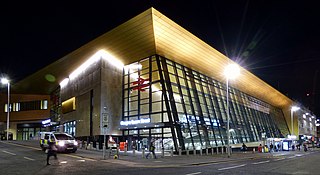
Glasgow Queen Street is a passenger railway terminus serving the city centre of Glasgow, Scotland. It is the smaller of the city's two mainline railway terminals and is the third-busiest station in Scotland behind Central and Edinburgh Waverley.
Princes Street is one of the major thoroughfares in central Edinburgh, Scotland and the main shopping street in the capital. It is the southernmost street of Edinburgh's New Town, stretching around 1.2 km from Lothian Road in the west, to Leith Street in the east. The street has few buildings on the south side and looks over Princes Street Gardens allowing panoramic views of the Old Town, Edinburgh Castle, as well as the valley between. Most of the street is limited to trams, buses and taxis with only the east end open to all traffic.

Edinburgh Waverley is the principal railway station serving Edinburgh, Scotland. It is the second busiest station in Scotland, after Glasgow Central. The station serves as the northern terminus of the East Coast Main Line, 393 miles 13 chains from London King's Cross, although some trains operated by London North Eastern Railway continue to other Scottish destinations beyond Edinburgh.

The Scott Monument is a Victorian Gothic monument to Scottish author Sir Walter Scott. It is the second-largest monument to a writer in the world after the José Martí monument in Havana. It stands in Princes Street Gardens in Edinburgh, opposite the former Jenners building on Princes Street and near Edinburgh Waverley Railway Station, which is named after Scott's Waverley novels.

Princes Street Gardens are two adjacent public parks in the centre of Edinburgh, Scotland, lying in the shadow of Edinburgh Castle. The Gardens were created in the 1820s following the long draining of the Nor Loch and building of the New Town, beginning in the 1760s.

The Balmoral Hotel is a hotel and landmark in Edinburgh, Scotland. It is located in the heart of the city at the east end of Princes Street, the main shopping street beneath the Edinburgh Castle rock, and the southern edge of the New Town.

Abbeyhill is an area of Edinburgh, the capital of Scotland.

The Nor Loch, also known as the Nor' Loch and the North Loch, was a man-made loch formerly in Edinburgh, Scotland, in the area now occupied by Princes Street Gardens and Waverley station which lie between the Royal Mile and Princes Street.
Edinburgh, the capital of Scotland, is traditionally said to have been "built on Seven Hills", in an allusion to the seven hills of Rome. While there is considerable room for debate as to which hills are included and excluded from the seven, seven possibilities are listed in an old rhyme:
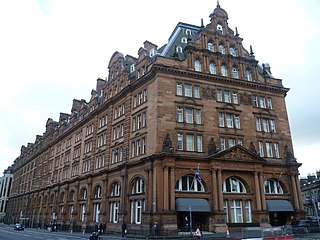
Princes Street Station was a mainline railway station which stood at the west end of Princes Street, in Edinburgh, Scotland, for almost 100 years. Temporary stations were opened in 1848 and 1870, with construction of the main station commencing in the 1890s. The station was closed completely in 1965 and largely demolished in 1969–70. Only its hotel remains, but it is no longer in railway ownership.
The Edinburgh Suburban and Southside Junction Railway was a railway company that built an east-west railway on the southern margin of Edinburgh, Scotland, primarily to facilitate the operation of heavy goods and mineral traffic across the city. The line opened in 1884. Although its route was rural at the time, suburban development quickly caught up and passenger carryings on the line were buoyant; the passenger service operated on a circular basis through Edinburgh Waverley railway station.
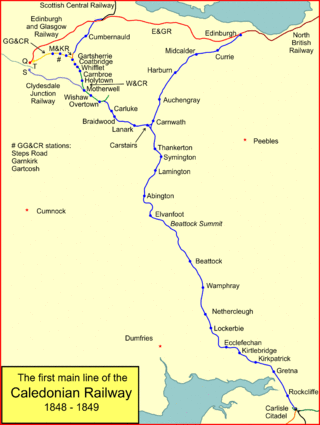
The Caledonian Railway main line in Scotland connected Glasgow and Edinburgh with Carlisle, via Carstairs and Beattock.

The Edinburgh, Leith and Newhaven Railway was a railway company formed in 1836 to connect the city of Edinburgh with the harbours on the Firth of Forth. When the line connected to Granton, the company name was changed to the Edinburgh, Leith and Granton Railway. It opened part of its route in 1846, but reaching the centre of Edinburgh involved the difficult construction of a long tunnel; this was opened in 1847. It was on a steep incline and was worked by rope haulage.

Waverley Market is a shopping centre in Edinburgh, Scotland.

North Bridge is a road bridge and street in Edinburgh linking the High Street with Princes Street, and the Old Town with the New Town. The current bridge was built between 1894 and 1897. A previous North Bridge, built between 1763 and 1772, stood until 1896.

Cockburn Street is a street in Edinburgh's Old Town, created as a serpentine link from the High Street to Waverley Station in 1856. Originally named Lord Cockburn Street after the then recently-deceased Scottish lawyer, judge and literary figure Henry, Lord Cockburn who was influential in urging his fellow citizens to remain vigilant in ensuring that early-Victorian expansion, e.g. improvements such as Cockburn Street, did not irrevocably damage or obliterate the built heritage and environment. Lord Cockburn's head is carved over the entrance to 1 Cockburn Street which now serves as offices for the Edinburgh Military Tattoo. The street contains a series of small specialist shops.
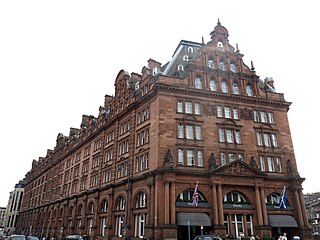
The Caledonian Edinburgh is a five-star hotel in Edinburgh, Scotland. Opened in 1903, it is an example of a British grand railway hotel. Nicknamed "The Caley", it stands at the west end of Princes Street and is a category A listed building.
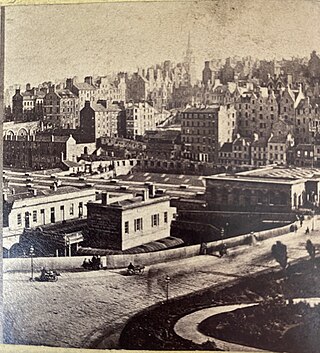
Waverley Bridge is a road bridge in Edinburgh linking Market Street and Cockburn Street in the Old Town with Princes Street in the New Town. The bridge forms part of the roof of Edinburgh Waverley station and marks the eastern boundary of Princes Street Gardens. The current bridge was built between 1894 and 1896 by Blyth and Westland; it is Category A listed as part of the station.
55°57′10″N3°11′24″W / 55.952811°N 3.190015°W